Detailed Analysis of Reward Management at the Uber Corporation
VerifiedAdded on 2022/11/19
|12
|4477
|496
Report
AI Summary
This report provides a comprehensive analysis of the reward management system implemented by Uber. It examines the company's approach to employee compensation, including the differentiation of pay based on factors such as experience, performance, and employment area. The report highlights the use of both extrinsic rewards (salary, incentives) and intrinsic rewards (environmental and development-oriented) to motivate employees. It explores the area of employment for drivers, the fair compensation system, and the role of performance targets and customer reviews in determining rewards. The report also discusses Uber's organizational strategies, the impact of environmental changes, and the conceptual framework behind its reward system, including fixed-price incentive awards and the application of theories like efficiency wage theory and agency theory. It also touches upon pay equity and the importance of training and development programs for employees. The report concludes by emphasizing the importance of reward management in supporting Uber's business strategy and motivating employees to achieve organizational goals.
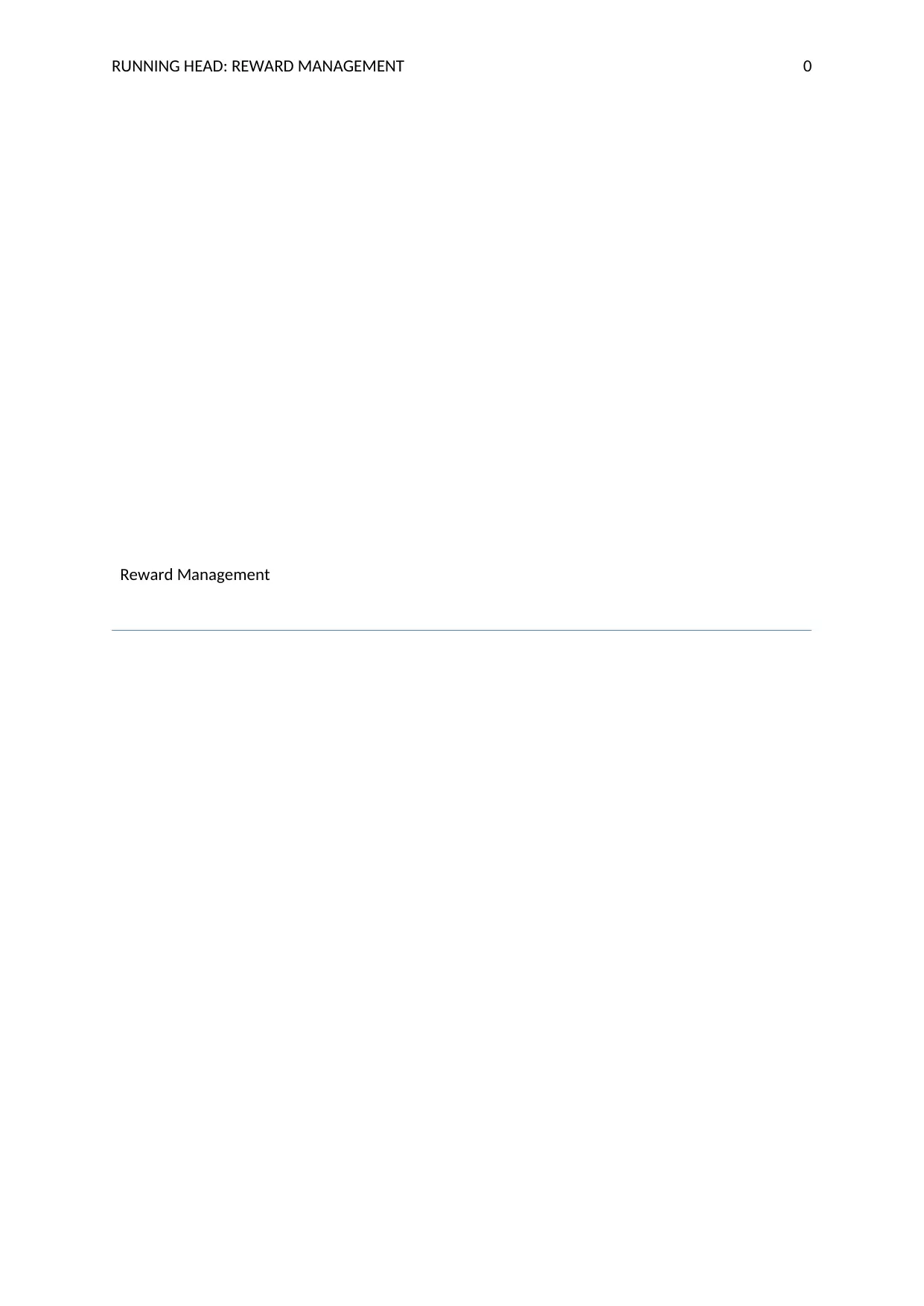
RUNNING HEAD: REWARD MANAGEMENT 0
Reward Management
Reward Management
Paraphrase This Document
Need a fresh take? Get an instant paraphrase of this document with our AI Paraphraser
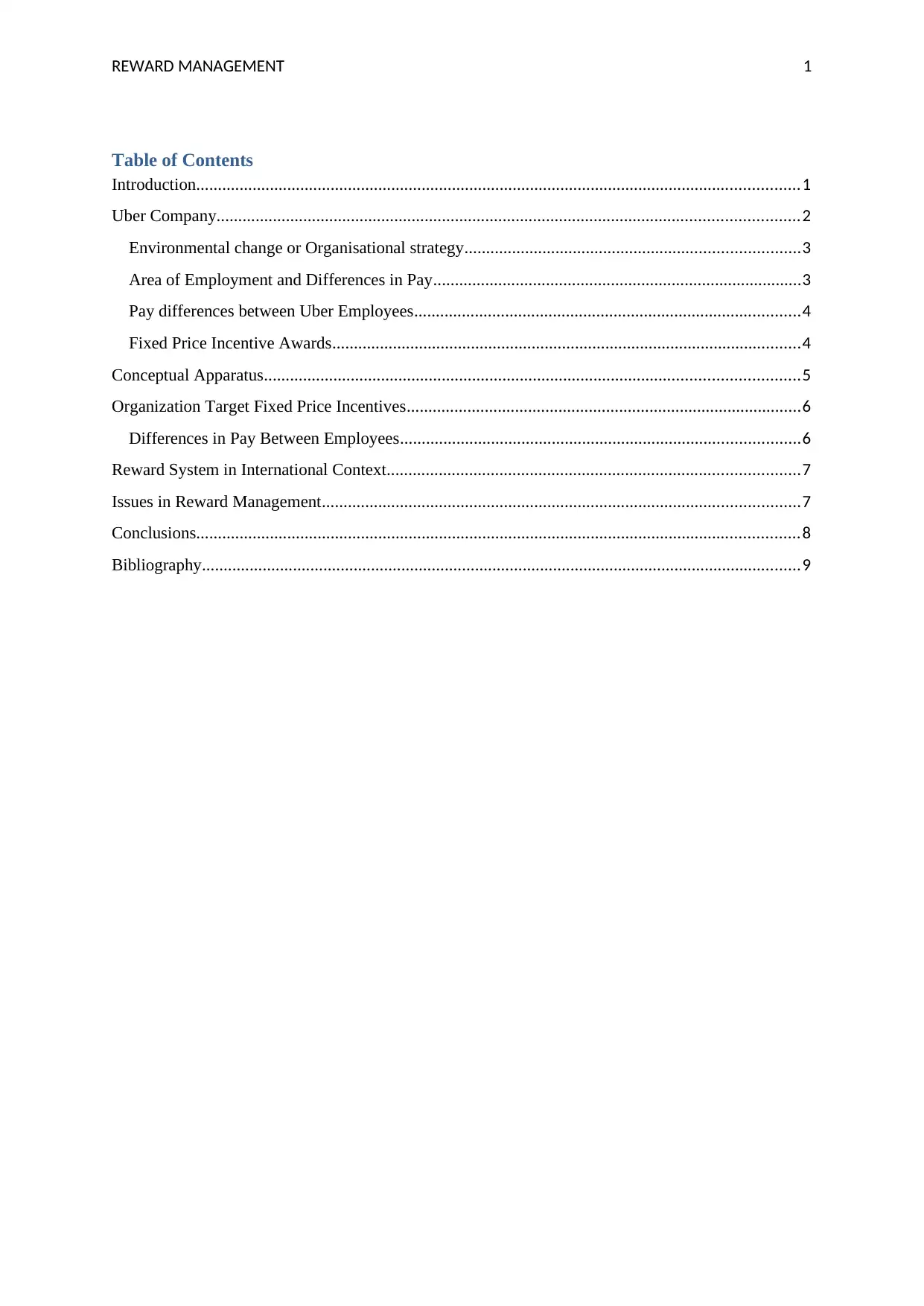
REWARD MANAGEMENT 1
Table of Contents
Introduction...........................................................................................................................................1
Uber Company......................................................................................................................................2
Environmental change or Organisational strategy.............................................................................3
Area of Employment and Differences in Pay.....................................................................................3
Pay differences between Uber Employees.........................................................................................4
Fixed Price Incentive Awards............................................................................................................4
Conceptual Apparatus...........................................................................................................................5
Organization Target Fixed Price Incentives...........................................................................................6
Differences in Pay Between Employees............................................................................................6
Reward System in International Context...............................................................................................7
Issues in Reward Management..............................................................................................................7
Conclusions...........................................................................................................................................8
Bibliography..........................................................................................................................................9
Table of Contents
Introduction...........................................................................................................................................1
Uber Company......................................................................................................................................2
Environmental change or Organisational strategy.............................................................................3
Area of Employment and Differences in Pay.....................................................................................3
Pay differences between Uber Employees.........................................................................................4
Fixed Price Incentive Awards............................................................................................................4
Conceptual Apparatus...........................................................................................................................5
Organization Target Fixed Price Incentives...........................................................................................6
Differences in Pay Between Employees............................................................................................6
Reward System in International Context...............................................................................................7
Issues in Reward Management..............................................................................................................7
Conclusions...........................................................................................................................................8
Bibliography..........................................................................................................................................9
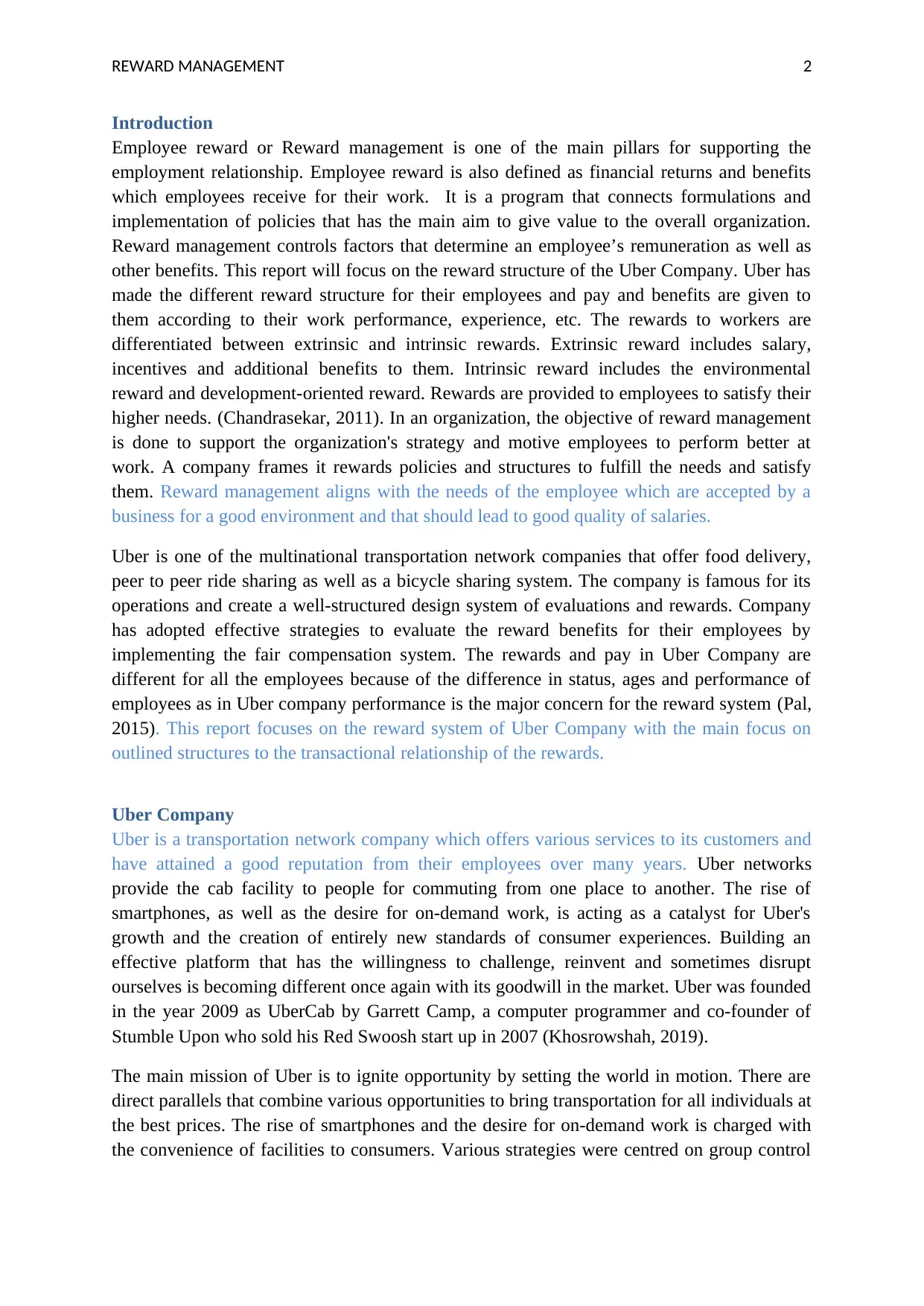
REWARD MANAGEMENT 2
Introduction
Employee reward or Reward management is one of the main pillars for supporting the
employment relationship. Employee reward is also defined as financial returns and benefits
which employees receive for their work. It is a program that connects formulations and
implementation of policies that has the main aim to give value to the overall organization.
Reward management controls factors that determine an employee’s remuneration as well as
other benefits. This report will focus on the reward structure of the Uber Company. Uber has
made the different reward structure for their employees and pay and benefits are given to
them according to their work performance, experience, etc. The rewards to workers are
differentiated between extrinsic and intrinsic rewards. Extrinsic reward includes salary,
incentives and additional benefits to them. Intrinsic reward includes the environmental
reward and development-oriented reward. Rewards are provided to employees to satisfy their
higher needs. (Chandrasekar, 2011). In an organization, the objective of reward management
is done to support the organization's strategy and motive employees to perform better at
work. A company frames it rewards policies and structures to fulfill the needs and satisfy
them. Reward management aligns with the needs of the employee which are accepted by a
business for a good environment and that should lead to good quality of salaries.
Uber is one of the multinational transportation network companies that offer food delivery,
peer to peer ride sharing as well as a bicycle sharing system. The company is famous for its
operations and create a well-structured design system of evaluations and rewards. Company
has adopted effective strategies to evaluate the reward benefits for their employees by
implementing the fair compensation system. The rewards and pay in Uber Company are
different for all the employees because of the difference in status, ages and performance of
employees as in Uber company performance is the major concern for the reward system (Pal,
2015). This report focuses on the reward system of Uber Company with the main focus on
outlined structures to the transactional relationship of the rewards.
Uber Company
Uber is a transportation network company which offers various services to its customers and
have attained a good reputation from their employees over many years. Uber networks
provide the cab facility to people for commuting from one place to another. The rise of
smartphones, as well as the desire for on-demand work, is acting as a catalyst for Uber's
growth and the creation of entirely new standards of consumer experiences. Building an
effective platform that has the willingness to challenge, reinvent and sometimes disrupt
ourselves is becoming different once again with its goodwill in the market. Uber was founded
in the year 2009 as UberCab by Garrett Camp, a computer programmer and co-founder of
Stumble Upon who sold his Red Swoosh start up in 2007 (Khosrowshah, 2019).
The main mission of Uber is to ignite opportunity by setting the world in motion. There are
direct parallels that combine various opportunities to bring transportation for all individuals at
the best prices. The rise of smartphones and the desire for on-demand work is charged with
the convenience of facilities to consumers. Various strategies were centred on group control
Introduction
Employee reward or Reward management is one of the main pillars for supporting the
employment relationship. Employee reward is also defined as financial returns and benefits
which employees receive for their work. It is a program that connects formulations and
implementation of policies that has the main aim to give value to the overall organization.
Reward management controls factors that determine an employee’s remuneration as well as
other benefits. This report will focus on the reward structure of the Uber Company. Uber has
made the different reward structure for their employees and pay and benefits are given to
them according to their work performance, experience, etc. The rewards to workers are
differentiated between extrinsic and intrinsic rewards. Extrinsic reward includes salary,
incentives and additional benefits to them. Intrinsic reward includes the environmental
reward and development-oriented reward. Rewards are provided to employees to satisfy their
higher needs. (Chandrasekar, 2011). In an organization, the objective of reward management
is done to support the organization's strategy and motive employees to perform better at
work. A company frames it rewards policies and structures to fulfill the needs and satisfy
them. Reward management aligns with the needs of the employee which are accepted by a
business for a good environment and that should lead to good quality of salaries.
Uber is one of the multinational transportation network companies that offer food delivery,
peer to peer ride sharing as well as a bicycle sharing system. The company is famous for its
operations and create a well-structured design system of evaluations and rewards. Company
has adopted effective strategies to evaluate the reward benefits for their employees by
implementing the fair compensation system. The rewards and pay in Uber Company are
different for all the employees because of the difference in status, ages and performance of
employees as in Uber company performance is the major concern for the reward system (Pal,
2015). This report focuses on the reward system of Uber Company with the main focus on
outlined structures to the transactional relationship of the rewards.
Uber Company
Uber is a transportation network company which offers various services to its customers and
have attained a good reputation from their employees over many years. Uber networks
provide the cab facility to people for commuting from one place to another. The rise of
smartphones, as well as the desire for on-demand work, is acting as a catalyst for Uber's
growth and the creation of entirely new standards of consumer experiences. Building an
effective platform that has the willingness to challenge, reinvent and sometimes disrupt
ourselves is becoming different once again with its goodwill in the market. Uber was founded
in the year 2009 as UberCab by Garrett Camp, a computer programmer and co-founder of
Stumble Upon who sold his Red Swoosh start up in 2007 (Khosrowshah, 2019).
The main mission of Uber is to ignite opportunity by setting the world in motion. There are
direct parallels that combine various opportunities to bring transportation for all individuals at
the best prices. The rise of smartphones and the desire for on-demand work is charged with
the convenience of facilities to consumers. Various strategies were centred on group control
⊘ This is a preview!⊘
Do you want full access?
Subscribe today to unlock all pages.

Trusted by 1+ million students worldwide
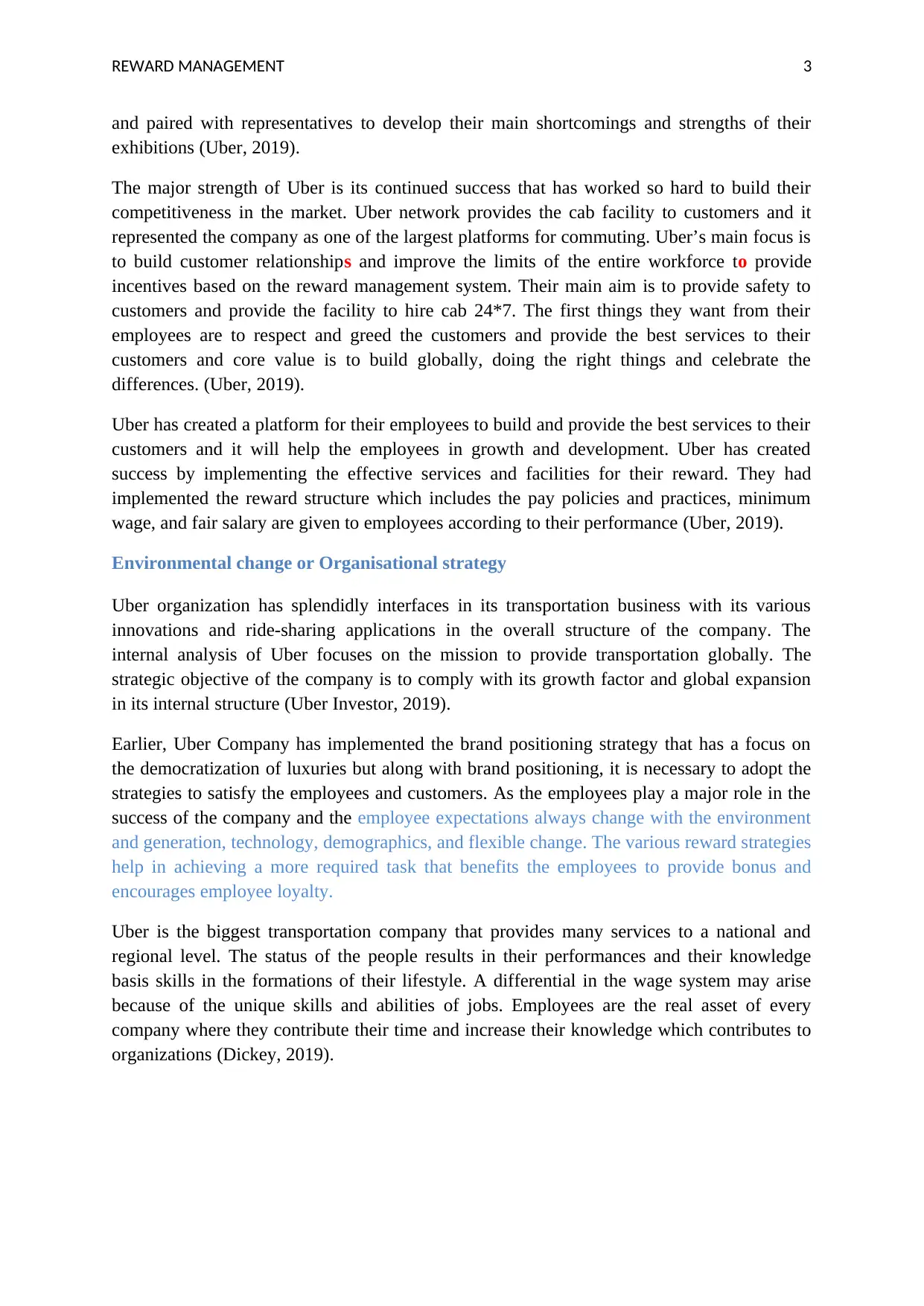
REWARD MANAGEMENT 3
and paired with representatives to develop their main shortcomings and strengths of their
exhibitions (Uber, 2019).
The major strength of Uber is its continued success that has worked so hard to build their
competitiveness in the market. Uber network provides the cab facility to customers and it
represented the company as one of the largest platforms for commuting. Uber’s main focus is
to build customer relationships and improve the limits of the entire workforce to provide
incentives based on the reward management system. Their main aim is to provide safety to
customers and provide the facility to hire cab 24*7. The first things they want from their
employees are to respect and greed the customers and provide the best services to their
customers and core value is to build globally, doing the right things and celebrate the
differences. (Uber, 2019).
Uber has created a platform for their employees to build and provide the best services to their
customers and it will help the employees in growth and development. Uber has created
success by implementing the effective services and facilities for their reward. They had
implemented the reward structure which includes the pay policies and practices, minimum
wage, and fair salary are given to employees according to their performance (Uber, 2019).
Environmental change or Organisational strategy
Uber organization has splendidly interfaces in its transportation business with its various
innovations and ride-sharing applications in the overall structure of the company. The
internal analysis of Uber focuses on the mission to provide transportation globally. The
strategic objective of the company is to comply with its growth factor and global expansion
in its internal structure (Uber Investor, 2019).
Earlier, Uber Company has implemented the brand positioning strategy that has a focus on
the democratization of luxuries but along with brand positioning, it is necessary to adopt the
strategies to satisfy the employees and customers. As the employees play a major role in the
success of the company and the employee expectations always change with the environment
and generation, technology, demographics, and flexible change. The various reward strategies
help in achieving a more required task that benefits the employees to provide bonus and
encourages employee loyalty.
Uber is the biggest transportation company that provides many services to a national and
regional level. The status of the people results in their performances and their knowledge
basis skills in the formations of their lifestyle. A differential in the wage system may arise
because of the unique skills and abilities of jobs. Employees are the real asset of every
company where they contribute their time and increase their knowledge which contributes to
organizations (Dickey, 2019).
and paired with representatives to develop their main shortcomings and strengths of their
exhibitions (Uber, 2019).
The major strength of Uber is its continued success that has worked so hard to build their
competitiveness in the market. Uber network provides the cab facility to customers and it
represented the company as one of the largest platforms for commuting. Uber’s main focus is
to build customer relationships and improve the limits of the entire workforce to provide
incentives based on the reward management system. Their main aim is to provide safety to
customers and provide the facility to hire cab 24*7. The first things they want from their
employees are to respect and greed the customers and provide the best services to their
customers and core value is to build globally, doing the right things and celebrate the
differences. (Uber, 2019).
Uber has created a platform for their employees to build and provide the best services to their
customers and it will help the employees in growth and development. Uber has created
success by implementing the effective services and facilities for their reward. They had
implemented the reward structure which includes the pay policies and practices, minimum
wage, and fair salary are given to employees according to their performance (Uber, 2019).
Environmental change or Organisational strategy
Uber organization has splendidly interfaces in its transportation business with its various
innovations and ride-sharing applications in the overall structure of the company. The
internal analysis of Uber focuses on the mission to provide transportation globally. The
strategic objective of the company is to comply with its growth factor and global expansion
in its internal structure (Uber Investor, 2019).
Earlier, Uber Company has implemented the brand positioning strategy that has a focus on
the democratization of luxuries but along with brand positioning, it is necessary to adopt the
strategies to satisfy the employees and customers. As the employees play a major role in the
success of the company and the employee expectations always change with the environment
and generation, technology, demographics, and flexible change. The various reward strategies
help in achieving a more required task that benefits the employees to provide bonus and
encourages employee loyalty.
Uber is the biggest transportation company that provides many services to a national and
regional level. The status of the people results in their performances and their knowledge
basis skills in the formations of their lifestyle. A differential in the wage system may arise
because of the unique skills and abilities of jobs. Employees are the real asset of every
company where they contribute their time and increase their knowledge which contributes to
organizations (Dickey, 2019).
Paraphrase This Document
Need a fresh take? Get an instant paraphrase of this document with our AI Paraphraser
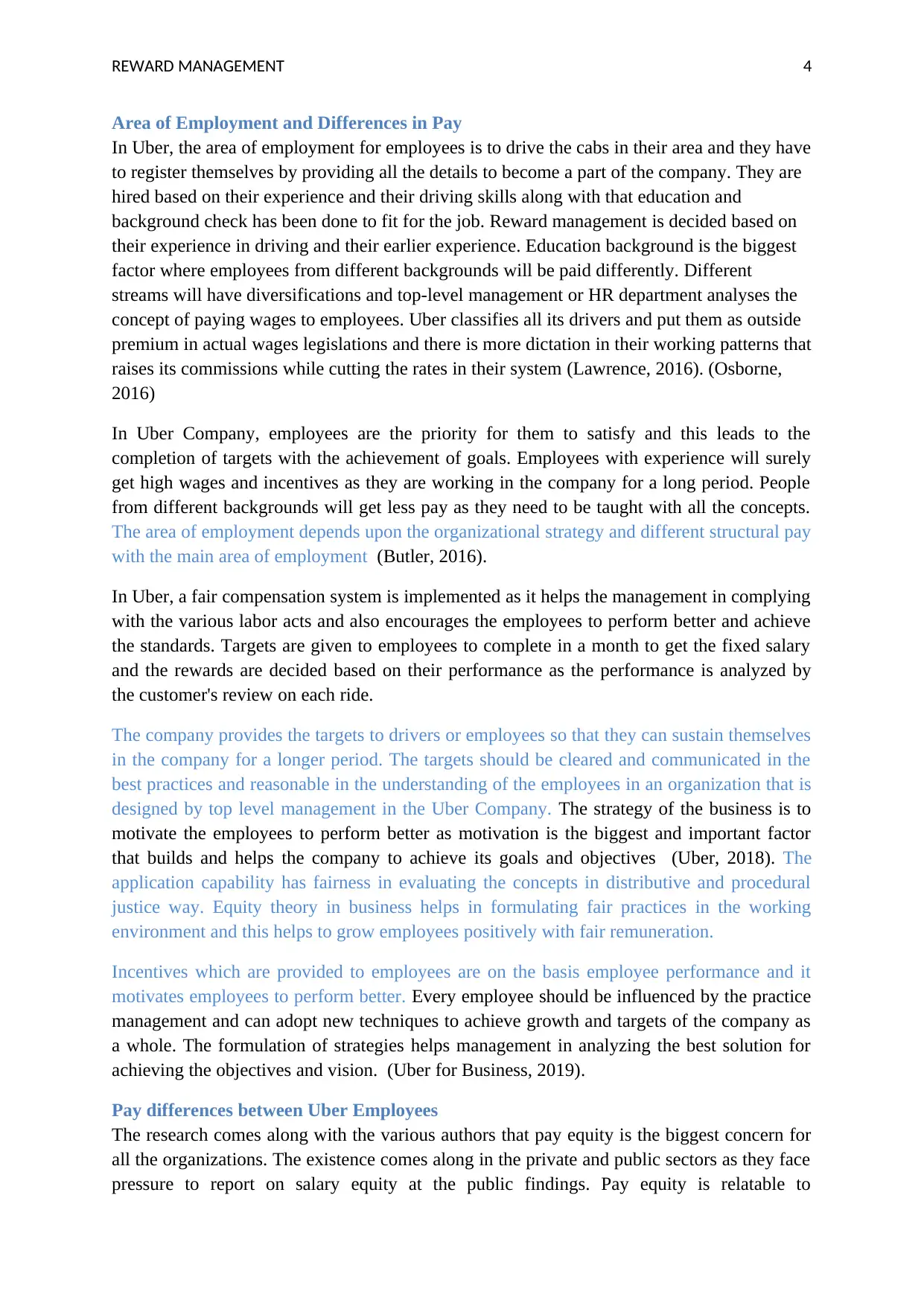
REWARD MANAGEMENT 4
Area of Employment and Differences in Pay
In Uber, the area of employment for employees is to drive the cabs in their area and they have
to register themselves by providing all the details to become a part of the company. They are
hired based on their experience and their driving skills along with that education and
background check has been done to fit for the job. Reward management is decided based on
their experience in driving and their earlier experience. Education background is the biggest
factor where employees from different backgrounds will be paid differently. Different
streams will have diversifications and top-level management or HR department analyses the
concept of paying wages to employees. Uber classifies all its drivers and put them as outside
premium in actual wages legislations and there is more dictation in their working patterns that
raises its commissions while cutting the rates in their system (Lawrence, 2016). (Osborne,
2016)
In Uber Company, employees are the priority for them to satisfy and this leads to the
completion of targets with the achievement of goals. Employees with experience will surely
get high wages and incentives as they are working in the company for a long period. People
from different backgrounds will get less pay as they need to be taught with all the concepts.
The area of employment depends upon the organizational strategy and different structural pay
with the main area of employment (Butler, 2016).
In Uber, a fair compensation system is implemented as it helps the management in complying
with the various labor acts and also encourages the employees to perform better and achieve
the standards. Targets are given to employees to complete in a month to get the fixed salary
and the rewards are decided based on their performance as the performance is analyzed by
the customer's review on each ride.
The company provides the targets to drivers or employees so that they can sustain themselves
in the company for a longer period. The targets should be cleared and communicated in the
best practices and reasonable in the understanding of the employees in an organization that is
designed by top level management in the Uber Company. The strategy of the business is to
motivate the employees to perform better as motivation is the biggest and important factor
that builds and helps the company to achieve its goals and objectives (Uber, 2018). The
application capability has fairness in evaluating the concepts in distributive and procedural
justice way. Equity theory in business helps in formulating fair practices in the working
environment and this helps to grow employees positively with fair remuneration.
Incentives which are provided to employees are on the basis employee performance and it
motivates employees to perform better. Every employee should be influenced by the practice
management and can adopt new techniques to achieve growth and targets of the company as
a whole. The formulation of strategies helps management in analyzing the best solution for
achieving the objectives and vision. (Uber for Business, 2019).
Pay differences between Uber Employees
The research comes along with the various authors that pay equity is the biggest concern for
all the organizations. The existence comes along in the private and public sectors as they face
pressure to report on salary equity at the public findings. Pay equity is relatable to
Area of Employment and Differences in Pay
In Uber, the area of employment for employees is to drive the cabs in their area and they have
to register themselves by providing all the details to become a part of the company. They are
hired based on their experience and their driving skills along with that education and
background check has been done to fit for the job. Reward management is decided based on
their experience in driving and their earlier experience. Education background is the biggest
factor where employees from different backgrounds will be paid differently. Different
streams will have diversifications and top-level management or HR department analyses the
concept of paying wages to employees. Uber classifies all its drivers and put them as outside
premium in actual wages legislations and there is more dictation in their working patterns that
raises its commissions while cutting the rates in their system (Lawrence, 2016). (Osborne,
2016)
In Uber Company, employees are the priority for them to satisfy and this leads to the
completion of targets with the achievement of goals. Employees with experience will surely
get high wages and incentives as they are working in the company for a long period. People
from different backgrounds will get less pay as they need to be taught with all the concepts.
The area of employment depends upon the organizational strategy and different structural pay
with the main area of employment (Butler, 2016).
In Uber, a fair compensation system is implemented as it helps the management in complying
with the various labor acts and also encourages the employees to perform better and achieve
the standards. Targets are given to employees to complete in a month to get the fixed salary
and the rewards are decided based on their performance as the performance is analyzed by
the customer's review on each ride.
The company provides the targets to drivers or employees so that they can sustain themselves
in the company for a longer period. The targets should be cleared and communicated in the
best practices and reasonable in the understanding of the employees in an organization that is
designed by top level management in the Uber Company. The strategy of the business is to
motivate the employees to perform better as motivation is the biggest and important factor
that builds and helps the company to achieve its goals and objectives (Uber, 2018). The
application capability has fairness in evaluating the concepts in distributive and procedural
justice way. Equity theory in business helps in formulating fair practices in the working
environment and this helps to grow employees positively with fair remuneration.
Incentives which are provided to employees are on the basis employee performance and it
motivates employees to perform better. Every employee should be influenced by the practice
management and can adopt new techniques to achieve growth and targets of the company as
a whole. The formulation of strategies helps management in analyzing the best solution for
achieving the objectives and vision. (Uber for Business, 2019).
Pay differences between Uber Employees
The research comes along with the various authors that pay equity is the biggest concern for
all the organizations. The existence comes along in the private and public sectors as they face
pressure to report on salary equity at the public findings. Pay equity is relatable to
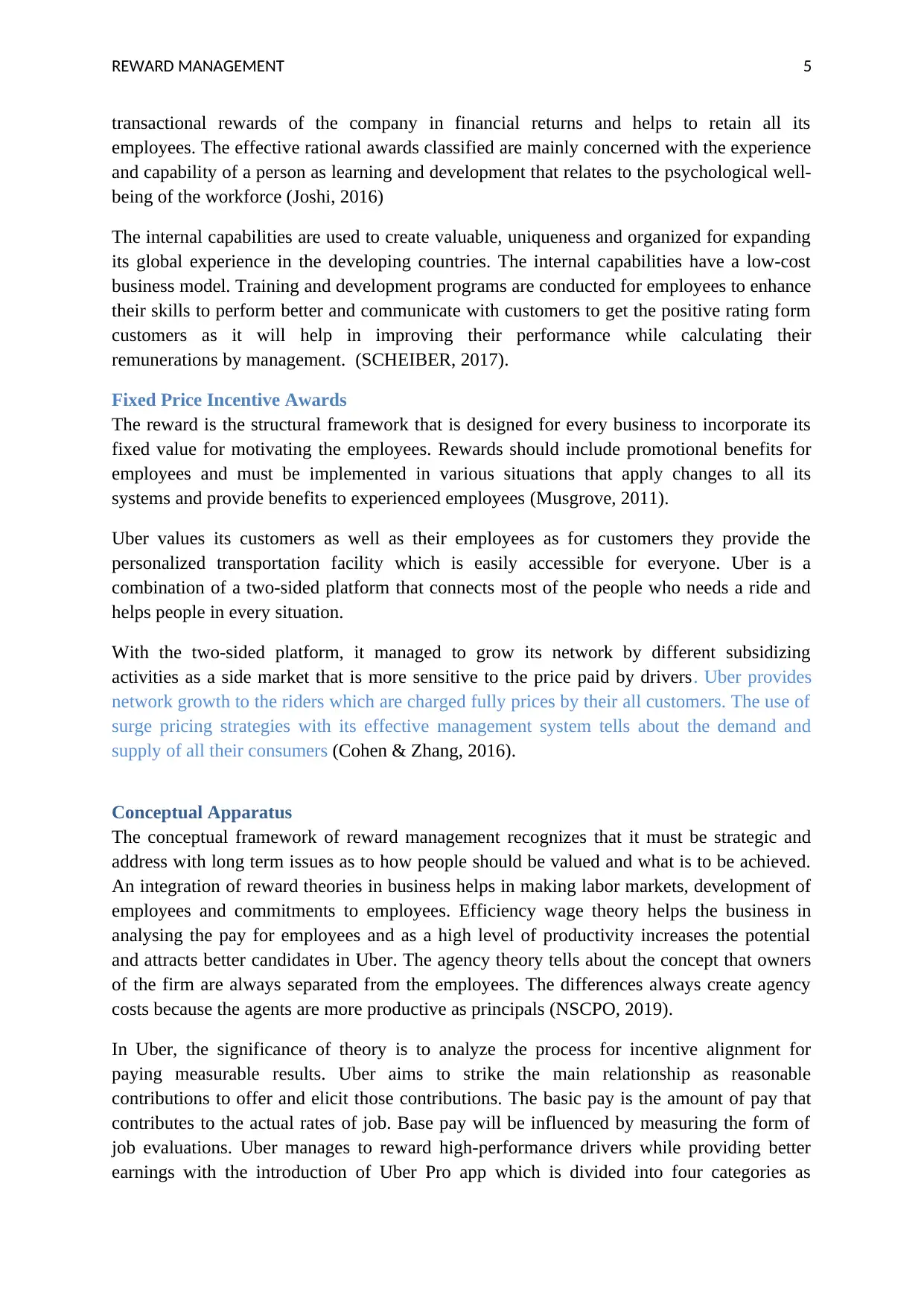
REWARD MANAGEMENT 5
transactional rewards of the company in financial returns and helps to retain all its
employees. The effective rational awards classified are mainly concerned with the experience
and capability of a person as learning and development that relates to the psychological well-
being of the workforce (Joshi, 2016)
The internal capabilities are used to create valuable, uniqueness and organized for expanding
its global experience in the developing countries. The internal capabilities have a low-cost
business model. Training and development programs are conducted for employees to enhance
their skills to perform better and communicate with customers to get the positive rating form
customers as it will help in improving their performance while calculating their
remunerations by management. (SCHEIBER, 2017).
Fixed Price Incentive Awards
The reward is the structural framework that is designed for every business to incorporate its
fixed value for motivating the employees. Rewards should include promotional benefits for
employees and must be implemented in various situations that apply changes to all its
systems and provide benefits to experienced employees (Musgrove, 2011).
Uber values its customers as well as their employees as for customers they provide the
personalized transportation facility which is easily accessible for everyone. Uber is a
combination of a two-sided platform that connects most of the people who needs a ride and
helps people in every situation.
With the two-sided platform, it managed to grow its network by different subsidizing
activities as a side market that is more sensitive to the price paid by drivers. Uber provides
network growth to the riders which are charged fully prices by their all customers. The use of
surge pricing strategies with its effective management system tells about the demand and
supply of all their consumers (Cohen & Zhang, 2016).
Conceptual Apparatus
The conceptual framework of reward management recognizes that it must be strategic and
address with long term issues as to how people should be valued and what is to be achieved.
An integration of reward theories in business helps in making labor markets, development of
employees and commitments to employees. Efficiency wage theory helps the business in
analysing the pay for employees and as a high level of productivity increases the potential
and attracts better candidates in Uber. The agency theory tells about the concept that owners
of the firm are always separated from the employees. The differences always create agency
costs because the agents are more productive as principals (NSCPO, 2019).
In Uber, the significance of theory is to analyze the process for incentive alignment for
paying measurable results. Uber aims to strike the main relationship as reasonable
contributions to offer and elicit those contributions. The basic pay is the amount of pay that
contributes to the actual rates of job. Base pay will be influenced by measuring the form of
job evaluations. Uber manages to reward high-performance drivers while providing better
earnings with the introduction of Uber Pro app which is divided into four categories as
transactional rewards of the company in financial returns and helps to retain all its
employees. The effective rational awards classified are mainly concerned with the experience
and capability of a person as learning and development that relates to the psychological well-
being of the workforce (Joshi, 2016)
The internal capabilities are used to create valuable, uniqueness and organized for expanding
its global experience in the developing countries. The internal capabilities have a low-cost
business model. Training and development programs are conducted for employees to enhance
their skills to perform better and communicate with customers to get the positive rating form
customers as it will help in improving their performance while calculating their
remunerations by management. (SCHEIBER, 2017).
Fixed Price Incentive Awards
The reward is the structural framework that is designed for every business to incorporate its
fixed value for motivating the employees. Rewards should include promotional benefits for
employees and must be implemented in various situations that apply changes to all its
systems and provide benefits to experienced employees (Musgrove, 2011).
Uber values its customers as well as their employees as for customers they provide the
personalized transportation facility which is easily accessible for everyone. Uber is a
combination of a two-sided platform that connects most of the people who needs a ride and
helps people in every situation.
With the two-sided platform, it managed to grow its network by different subsidizing
activities as a side market that is more sensitive to the price paid by drivers. Uber provides
network growth to the riders which are charged fully prices by their all customers. The use of
surge pricing strategies with its effective management system tells about the demand and
supply of all their consumers (Cohen & Zhang, 2016).
Conceptual Apparatus
The conceptual framework of reward management recognizes that it must be strategic and
address with long term issues as to how people should be valued and what is to be achieved.
An integration of reward theories in business helps in making labor markets, development of
employees and commitments to employees. Efficiency wage theory helps the business in
analysing the pay for employees and as a high level of productivity increases the potential
and attracts better candidates in Uber. The agency theory tells about the concept that owners
of the firm are always separated from the employees. The differences always create agency
costs because the agents are more productive as principals (NSCPO, 2019).
In Uber, the significance of theory is to analyze the process for incentive alignment for
paying measurable results. Uber aims to strike the main relationship as reasonable
contributions to offer and elicit those contributions. The basic pay is the amount of pay that
contributes to the actual rates of job. Base pay will be influenced by measuring the form of
job evaluations. Uber manages to reward high-performance drivers while providing better
earnings with the introduction of Uber Pro app which is divided into four categories as
⊘ This is a preview!⊘
Do you want full access?
Subscribe today to unlock all pages.

Trusted by 1+ million students worldwide
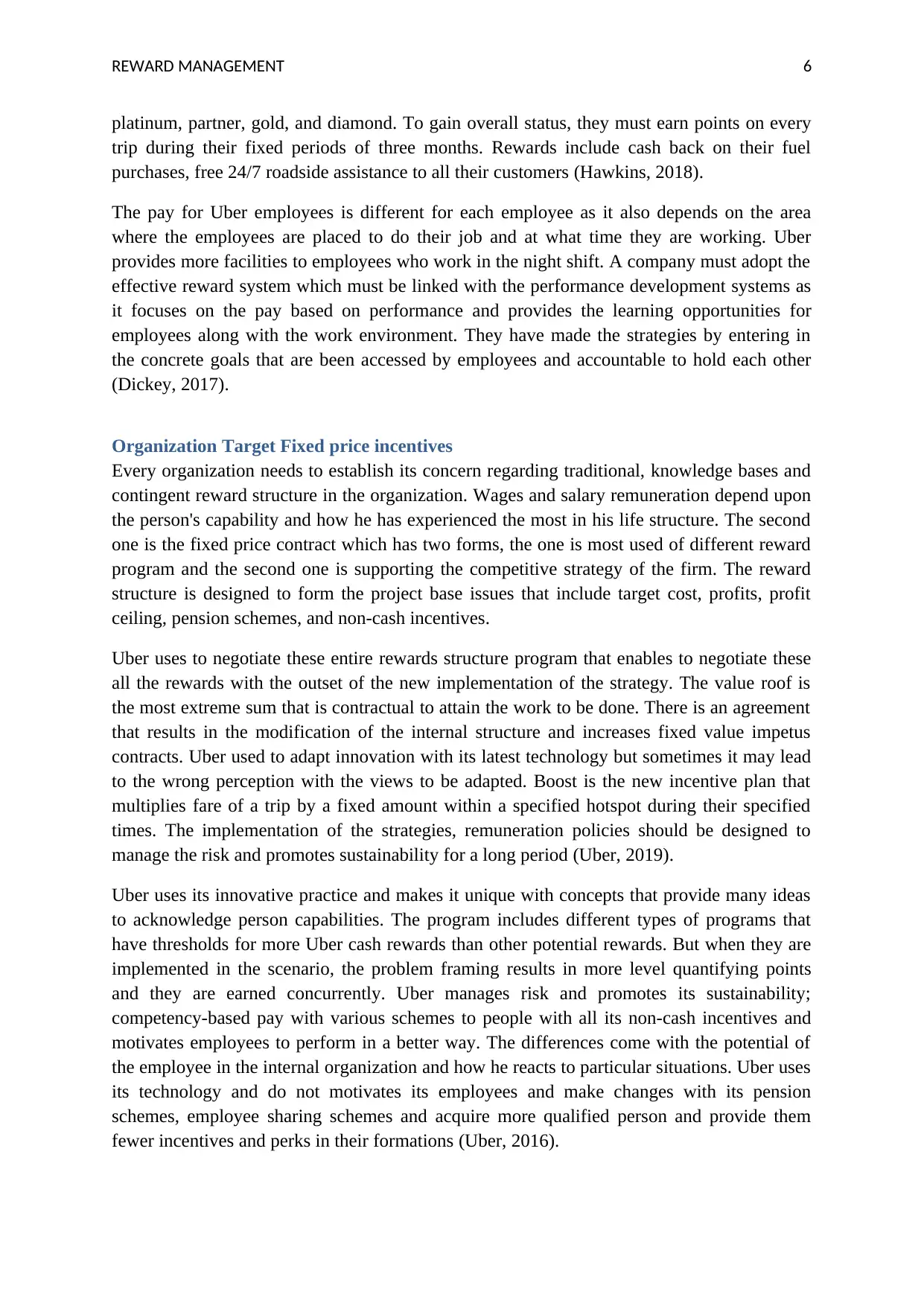
REWARD MANAGEMENT 6
platinum, partner, gold, and diamond. To gain overall status, they must earn points on every
trip during their fixed periods of three months. Rewards include cash back on their fuel
purchases, free 24/7 roadside assistance to all their customers (Hawkins, 2018).
The pay for Uber employees is different for each employee as it also depends on the area
where the employees are placed to do their job and at what time they are working. Uber
provides more facilities to employees who work in the night shift. A company must adopt the
effective reward system which must be linked with the performance development systems as
it focuses on the pay based on performance and provides the learning opportunities for
employees along with the work environment. They have made the strategies by entering in
the concrete goals that are been accessed by employees and accountable to hold each other
(Dickey, 2017).
Organization Target Fixed price incentives
Every organization needs to establish its concern regarding traditional, knowledge bases and
contingent reward structure in the organization. Wages and salary remuneration depend upon
the person's capability and how he has experienced the most in his life structure. The second
one is the fixed price contract which has two forms, the one is most used of different reward
program and the second one is supporting the competitive strategy of the firm. The reward
structure is designed to form the project base issues that include target cost, profits, profit
ceiling, pension schemes, and non-cash incentives.
Uber uses to negotiate these entire rewards structure program that enables to negotiate these
all the rewards with the outset of the new implementation of the strategy. The value roof is
the most extreme sum that is contractual to attain the work to be done. There is an agreement
that results in the modification of the internal structure and increases fixed value impetus
contracts. Uber used to adapt innovation with its latest technology but sometimes it may lead
to the wrong perception with the views to be adapted. Boost is the new incentive plan that
multiplies fare of a trip by a fixed amount within a specified hotspot during their specified
times. The implementation of the strategies, remuneration policies should be designed to
manage the risk and promotes sustainability for a long period (Uber, 2019).
Uber uses its innovative practice and makes it unique with concepts that provide many ideas
to acknowledge person capabilities. The program includes different types of programs that
have thresholds for more Uber cash rewards than other potential rewards. But when they are
implemented in the scenario, the problem framing results in more level quantifying points
and they are earned concurrently. Uber manages risk and promotes its sustainability;
competency-based pay with various schemes to people with all its non-cash incentives and
motivates employees to perform in a better way. The differences come with the potential of
the employee in the internal organization and how he reacts to particular situations. Uber uses
its technology and do not motivates its employees and make changes with its pension
schemes, employee sharing schemes and acquire more qualified person and provide them
fewer incentives and perks in their formations (Uber, 2016).
platinum, partner, gold, and diamond. To gain overall status, they must earn points on every
trip during their fixed periods of three months. Rewards include cash back on their fuel
purchases, free 24/7 roadside assistance to all their customers (Hawkins, 2018).
The pay for Uber employees is different for each employee as it also depends on the area
where the employees are placed to do their job and at what time they are working. Uber
provides more facilities to employees who work in the night shift. A company must adopt the
effective reward system which must be linked with the performance development systems as
it focuses on the pay based on performance and provides the learning opportunities for
employees along with the work environment. They have made the strategies by entering in
the concrete goals that are been accessed by employees and accountable to hold each other
(Dickey, 2017).
Organization Target Fixed price incentives
Every organization needs to establish its concern regarding traditional, knowledge bases and
contingent reward structure in the organization. Wages and salary remuneration depend upon
the person's capability and how he has experienced the most in his life structure. The second
one is the fixed price contract which has two forms, the one is most used of different reward
program and the second one is supporting the competitive strategy of the firm. The reward
structure is designed to form the project base issues that include target cost, profits, profit
ceiling, pension schemes, and non-cash incentives.
Uber uses to negotiate these entire rewards structure program that enables to negotiate these
all the rewards with the outset of the new implementation of the strategy. The value roof is
the most extreme sum that is contractual to attain the work to be done. There is an agreement
that results in the modification of the internal structure and increases fixed value impetus
contracts. Uber used to adapt innovation with its latest technology but sometimes it may lead
to the wrong perception with the views to be adapted. Boost is the new incentive plan that
multiplies fare of a trip by a fixed amount within a specified hotspot during their specified
times. The implementation of the strategies, remuneration policies should be designed to
manage the risk and promotes sustainability for a long period (Uber, 2019).
Uber uses its innovative practice and makes it unique with concepts that provide many ideas
to acknowledge person capabilities. The program includes different types of programs that
have thresholds for more Uber cash rewards than other potential rewards. But when they are
implemented in the scenario, the problem framing results in more level quantifying points
and they are earned concurrently. Uber manages risk and promotes its sustainability;
competency-based pay with various schemes to people with all its non-cash incentives and
motivates employees to perform in a better way. The differences come with the potential of
the employee in the internal organization and how he reacts to particular situations. Uber uses
its technology and do not motivates its employees and make changes with its pension
schemes, employee sharing schemes and acquire more qualified person and provide them
fewer incentives and perks in their formations (Uber, 2016).
Paraphrase This Document
Need a fresh take? Get an instant paraphrase of this document with our AI Paraphraser
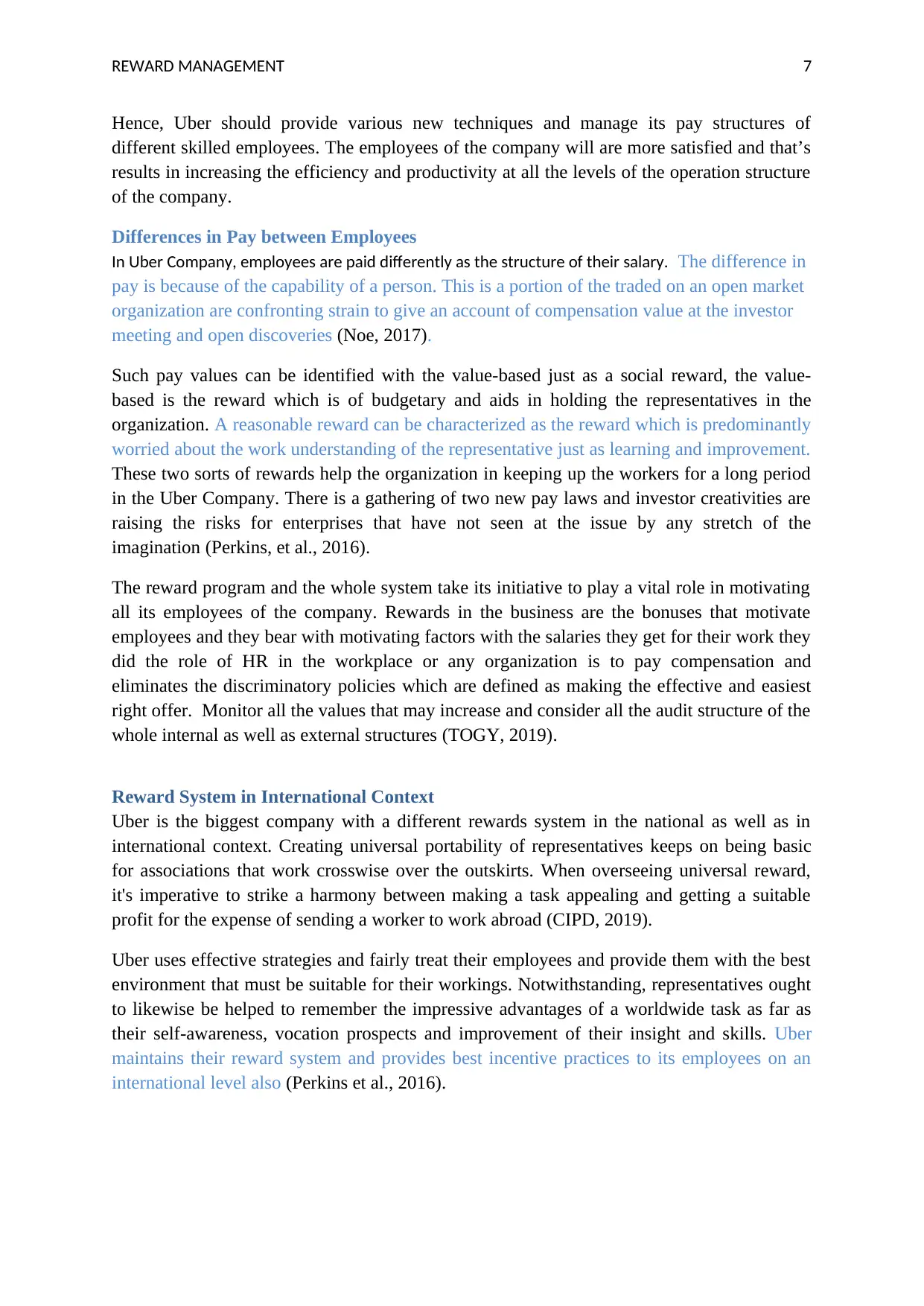
REWARD MANAGEMENT 7
Hence, Uber should provide various new techniques and manage its pay structures of
different skilled employees. The employees of the company will are more satisfied and that’s
results in increasing the efficiency and productivity at all the levels of the operation structure
of the company.
Differences in Pay between Employees
In Uber Company, employees are paid differently as the structure of their salary. The difference in
pay is because of the capability of a person. This is a portion of the traded on an open market
organization are confronting strain to give an account of compensation value at the investor
meeting and open discoveries (Noe, 2017).
Such pay values can be identified with the value-based just as a social reward, the value-
based is the reward which is of budgetary and aids in holding the representatives in the
organization. A reasonable reward can be characterized as the reward which is predominantly
worried about the work understanding of the representative just as learning and improvement.
These two sorts of rewards help the organization in keeping up the workers for a long period
in the Uber Company. There is a gathering of two new pay laws and investor creativities are
raising the risks for enterprises that have not seen at the issue by any stretch of the
imagination (Perkins, et al., 2016).
The reward program and the whole system take its initiative to play a vital role in motivating
all its employees of the company. Rewards in the business are the bonuses that motivate
employees and they bear with motivating factors with the salaries they get for their work they
did the role of HR in the workplace or any organization is to pay compensation and
eliminates the discriminatory policies which are defined as making the effective and easiest
right offer. Monitor all the values that may increase and consider all the audit structure of the
whole internal as well as external structures (TOGY, 2019).
Reward System in International Context
Uber is the biggest company with a different rewards system in the national as well as in
international context. Creating universal portability of representatives keeps on being basic
for associations that work crosswise over the outskirts. When overseeing universal reward,
it's imperative to strike a harmony between making a task appealing and getting a suitable
profit for the expense of sending a worker to work abroad (CIPD, 2019).
Uber uses effective strategies and fairly treat their employees and provide them with the best
environment that must be suitable for their workings. Notwithstanding, representatives ought
to likewise be helped to remember the impressive advantages of a worldwide task as far as
their self-awareness, vocation prospects and improvement of their insight and skills. Uber
maintains their reward system and provides best incentive practices to its employees on an
international level also (Perkins et al., 2016).
Hence, Uber should provide various new techniques and manage its pay structures of
different skilled employees. The employees of the company will are more satisfied and that’s
results in increasing the efficiency and productivity at all the levels of the operation structure
of the company.
Differences in Pay between Employees
In Uber Company, employees are paid differently as the structure of their salary. The difference in
pay is because of the capability of a person. This is a portion of the traded on an open market
organization are confronting strain to give an account of compensation value at the investor
meeting and open discoveries (Noe, 2017).
Such pay values can be identified with the value-based just as a social reward, the value-
based is the reward which is of budgetary and aids in holding the representatives in the
organization. A reasonable reward can be characterized as the reward which is predominantly
worried about the work understanding of the representative just as learning and improvement.
These two sorts of rewards help the organization in keeping up the workers for a long period
in the Uber Company. There is a gathering of two new pay laws and investor creativities are
raising the risks for enterprises that have not seen at the issue by any stretch of the
imagination (Perkins, et al., 2016).
The reward program and the whole system take its initiative to play a vital role in motivating
all its employees of the company. Rewards in the business are the bonuses that motivate
employees and they bear with motivating factors with the salaries they get for their work they
did the role of HR in the workplace or any organization is to pay compensation and
eliminates the discriminatory policies which are defined as making the effective and easiest
right offer. Monitor all the values that may increase and consider all the audit structure of the
whole internal as well as external structures (TOGY, 2019).
Reward System in International Context
Uber is the biggest company with a different rewards system in the national as well as in
international context. Creating universal portability of representatives keeps on being basic
for associations that work crosswise over the outskirts. When overseeing universal reward,
it's imperative to strike a harmony between making a task appealing and getting a suitable
profit for the expense of sending a worker to work abroad (CIPD, 2019).
Uber uses effective strategies and fairly treat their employees and provide them with the best
environment that must be suitable for their workings. Notwithstanding, representatives ought
to likewise be helped to remember the impressive advantages of a worldwide task as far as
their self-awareness, vocation prospects and improvement of their insight and skills. Uber
maintains their reward system and provides best incentive practices to its employees on an
international level also (Perkins et al., 2016).
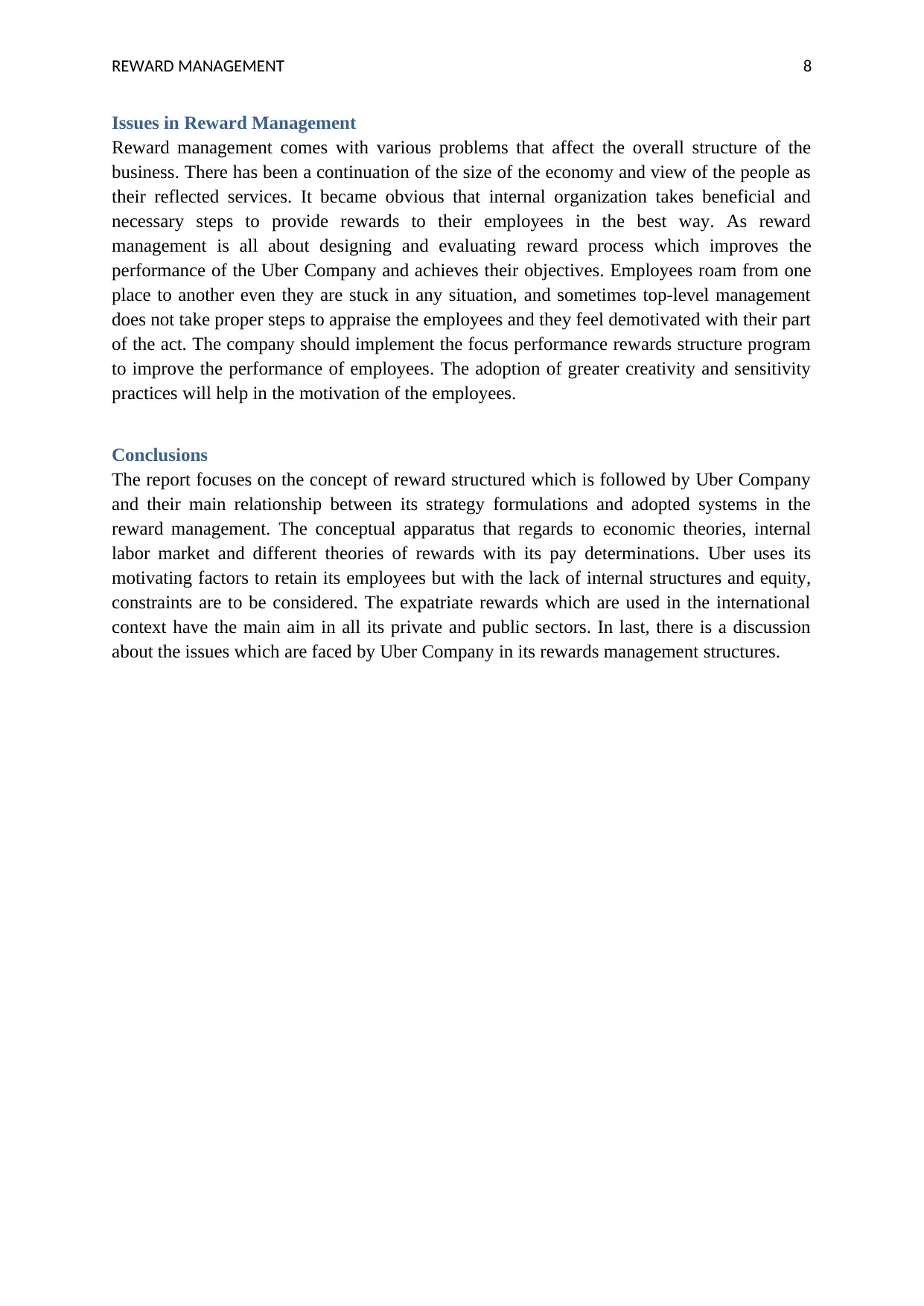
REWARD MANAGEMENT 8
Issues in Reward Management
Reward management comes with various problems that affect the overall structure of the
business. There has been a continuation of the size of the economy and view of the people as
their reflected services. It became obvious that internal organization takes beneficial and
necessary steps to provide rewards to their employees in the best way. As reward
management is all about designing and evaluating reward process which improves the
performance of the Uber Company and achieves their objectives. Employees roam from one
place to another even they are stuck in any situation, and sometimes top-level management
does not take proper steps to appraise the employees and they feel demotivated with their part
of the act. The company should implement the focus performance rewards structure program
to improve the performance of employees. The adoption of greater creativity and sensitivity
practices will help in the motivation of the employees.
Conclusions
The report focuses on the concept of reward structured which is followed by Uber Company
and their main relationship between its strategy formulations and adopted systems in the
reward management. The conceptual apparatus that regards to economic theories, internal
labor market and different theories of rewards with its pay determinations. Uber uses its
motivating factors to retain its employees but with the lack of internal structures and equity,
constraints are to be considered. The expatriate rewards which are used in the international
context have the main aim in all its private and public sectors. In last, there is a discussion
about the issues which are faced by Uber Company in its rewards management structures.
Issues in Reward Management
Reward management comes with various problems that affect the overall structure of the
business. There has been a continuation of the size of the economy and view of the people as
their reflected services. It became obvious that internal organization takes beneficial and
necessary steps to provide rewards to their employees in the best way. As reward
management is all about designing and evaluating reward process which improves the
performance of the Uber Company and achieves their objectives. Employees roam from one
place to another even they are stuck in any situation, and sometimes top-level management
does not take proper steps to appraise the employees and they feel demotivated with their part
of the act. The company should implement the focus performance rewards structure program
to improve the performance of employees. The adoption of greater creativity and sensitivity
practices will help in the motivation of the employees.
Conclusions
The report focuses on the concept of reward structured which is followed by Uber Company
and their main relationship between its strategy formulations and adopted systems in the
reward management. The conceptual apparatus that regards to economic theories, internal
labor market and different theories of rewards with its pay determinations. Uber uses its
motivating factors to retain its employees but with the lack of internal structures and equity,
constraints are to be considered. The expatriate rewards which are used in the international
context have the main aim in all its private and public sectors. In last, there is a discussion
about the issues which are faced by Uber Company in its rewards management structures.
⊘ This is a preview!⊘
Do you want full access?
Subscribe today to unlock all pages.

Trusted by 1+ million students worldwide
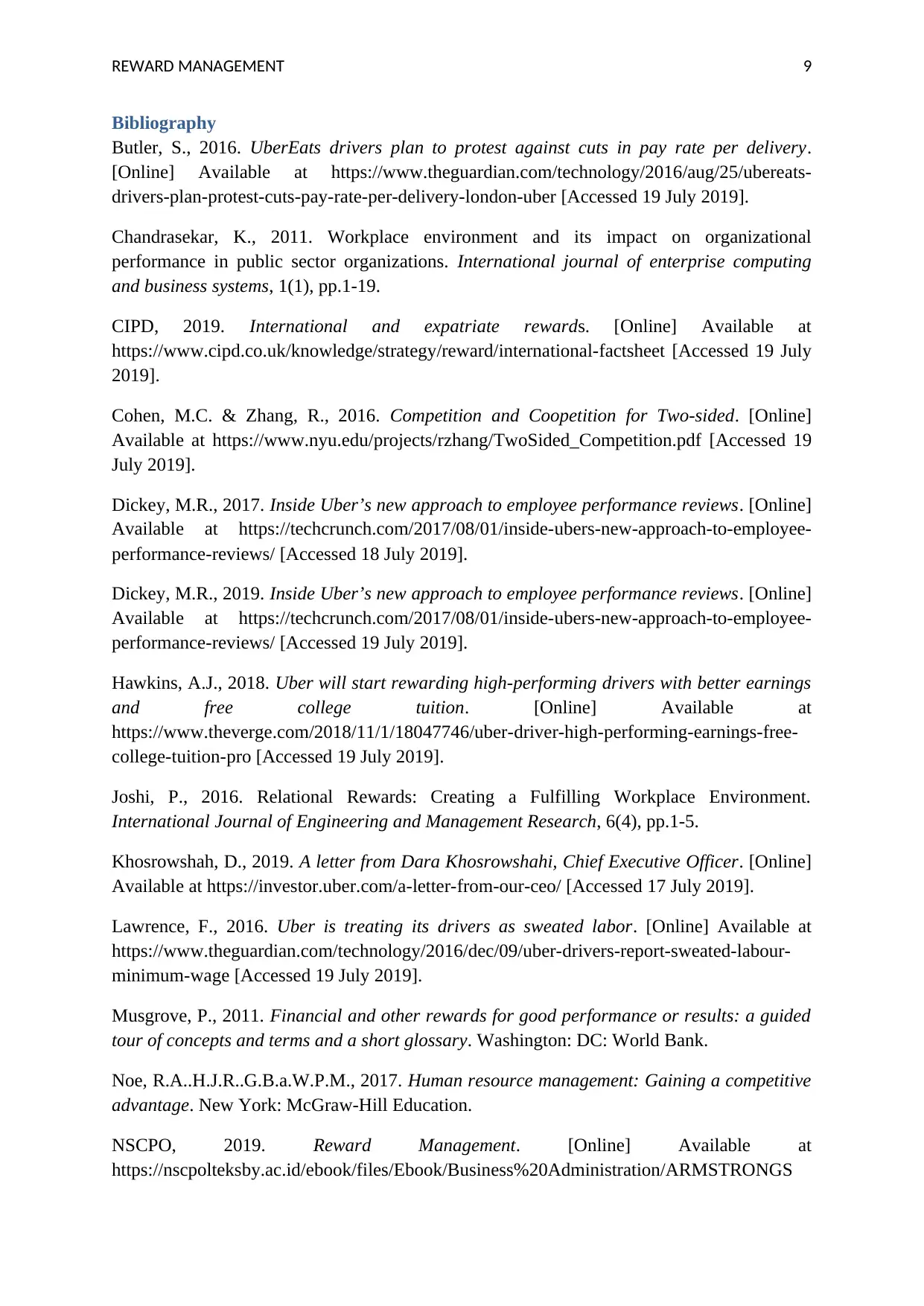
REWARD MANAGEMENT 9
Bibliography
Butler, S., 2016. UberEats drivers plan to protest against cuts in pay rate per delivery.
[Online] Available at https://www.theguardian.com/technology/2016/aug/25/ubereats-
drivers-plan-protest-cuts-pay-rate-per-delivery-london-uber [Accessed 19 July 2019].
Chandrasekar, K., 2011. Workplace environment and its impact on organizational
performance in public sector organizations. International journal of enterprise computing
and business systems, 1(1), pp.1-19.
CIPD, 2019. International and expatriate rewards. [Online] Available at
https://www.cipd.co.uk/knowledge/strategy/reward/international-factsheet [Accessed 19 July
2019].
Cohen, M.C. & Zhang, R., 2016. Competition and Coopetition for Two-sided. [Online]
Available at https://www.nyu.edu/projects/rzhang/TwoSided_Competition.pdf [Accessed 19
July 2019].
Dickey, M.R., 2017. Inside Uber’s new approach to employee performance reviews. [Online]
Available at https://techcrunch.com/2017/08/01/inside-ubers-new-approach-to-employee-
performance-reviews/ [Accessed 18 July 2019].
Dickey, M.R., 2019. Inside Uber’s new approach to employee performance reviews. [Online]
Available at https://techcrunch.com/2017/08/01/inside-ubers-new-approach-to-employee-
performance-reviews/ [Accessed 19 July 2019].
Hawkins, A.J., 2018. Uber will start rewarding high-performing drivers with better earnings
and free college tuition. [Online] Available at
https://www.theverge.com/2018/11/1/18047746/uber-driver-high-performing-earnings-free-
college-tuition-pro [Accessed 19 July 2019].
Joshi, P., 2016. Relational Rewards: Creating a Fulfilling Workplace Environment.
International Journal of Engineering and Management Research, 6(4), pp.1-5.
Khosrowshah, D., 2019. A letter from Dara Khosrowshahi, Chief Executive Officer. [Online]
Available at https://investor.uber.com/a-letter-from-our-ceo/ [Accessed 17 July 2019].
Lawrence, F., 2016. Uber is treating its drivers as sweated labor. [Online] Available at
https://www.theguardian.com/technology/2016/dec/09/uber-drivers-report-sweated-labour-
minimum-wage [Accessed 19 July 2019].
Musgrove, P., 2011. Financial and other rewards for good performance or results: a guided
tour of concepts and terms and a short glossary. Washington: DC: World Bank.
Noe, R.A..H.J.R..G.B.a.W.P.M., 2017. Human resource management: Gaining a competitive
advantage. New York: McGraw-Hill Education.
NSCPO, 2019. Reward Management. [Online] Available at
https://nscpolteksby.ac.id/ebook/files/Ebook/Business%20Administration/ARMSTRONGS
Bibliography
Butler, S., 2016. UberEats drivers plan to protest against cuts in pay rate per delivery.
[Online] Available at https://www.theguardian.com/technology/2016/aug/25/ubereats-
drivers-plan-protest-cuts-pay-rate-per-delivery-london-uber [Accessed 19 July 2019].
Chandrasekar, K., 2011. Workplace environment and its impact on organizational
performance in public sector organizations. International journal of enterprise computing
and business systems, 1(1), pp.1-19.
CIPD, 2019. International and expatriate rewards. [Online] Available at
https://www.cipd.co.uk/knowledge/strategy/reward/international-factsheet [Accessed 19 July
2019].
Cohen, M.C. & Zhang, R., 2016. Competition and Coopetition for Two-sided. [Online]
Available at https://www.nyu.edu/projects/rzhang/TwoSided_Competition.pdf [Accessed 19
July 2019].
Dickey, M.R., 2017. Inside Uber’s new approach to employee performance reviews. [Online]
Available at https://techcrunch.com/2017/08/01/inside-ubers-new-approach-to-employee-
performance-reviews/ [Accessed 18 July 2019].
Dickey, M.R., 2019. Inside Uber’s new approach to employee performance reviews. [Online]
Available at https://techcrunch.com/2017/08/01/inside-ubers-new-approach-to-employee-
performance-reviews/ [Accessed 19 July 2019].
Hawkins, A.J., 2018. Uber will start rewarding high-performing drivers with better earnings
and free college tuition. [Online] Available at
https://www.theverge.com/2018/11/1/18047746/uber-driver-high-performing-earnings-free-
college-tuition-pro [Accessed 19 July 2019].
Joshi, P., 2016. Relational Rewards: Creating a Fulfilling Workplace Environment.
International Journal of Engineering and Management Research, 6(4), pp.1-5.
Khosrowshah, D., 2019. A letter from Dara Khosrowshahi, Chief Executive Officer. [Online]
Available at https://investor.uber.com/a-letter-from-our-ceo/ [Accessed 17 July 2019].
Lawrence, F., 2016. Uber is treating its drivers as sweated labor. [Online] Available at
https://www.theguardian.com/technology/2016/dec/09/uber-drivers-report-sweated-labour-
minimum-wage [Accessed 19 July 2019].
Musgrove, P., 2011. Financial and other rewards for good performance or results: a guided
tour of concepts and terms and a short glossary. Washington: DC: World Bank.
Noe, R.A..H.J.R..G.B.a.W.P.M., 2017. Human resource management: Gaining a competitive
advantage. New York: McGraw-Hill Education.
NSCPO, 2019. Reward Management. [Online] Available at
https://nscpolteksby.ac.id/ebook/files/Ebook/Business%20Administration/ARMSTRONGS
Paraphrase This Document
Need a fresh take? Get an instant paraphrase of this document with our AI Paraphraser
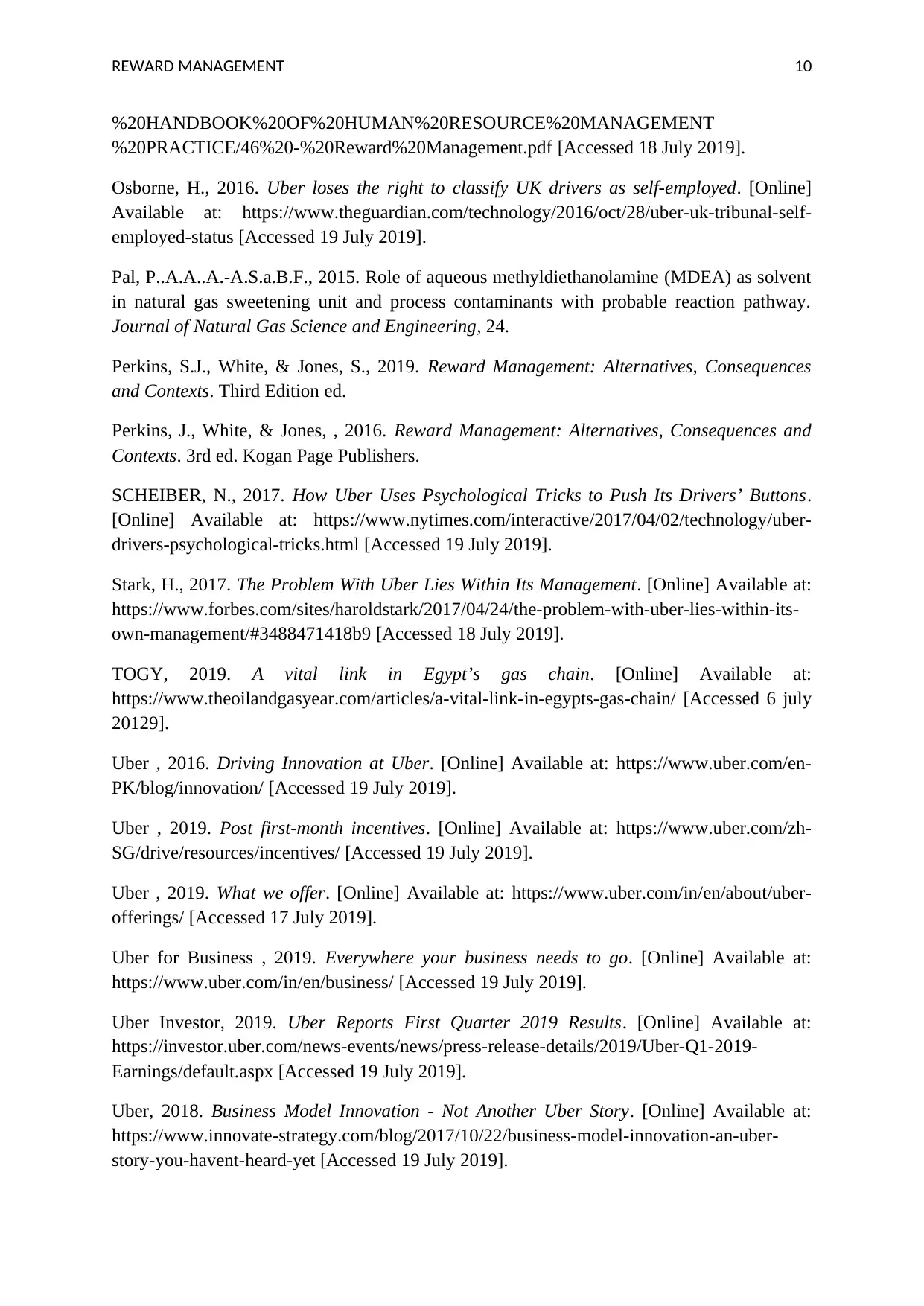
REWARD MANAGEMENT 10
%20HANDBOOK%20OF%20HUMAN%20RESOURCE%20MANAGEMENT
%20PRACTICE/46%20-%20Reward%20Management.pdf [Accessed 18 July 2019].
Osborne, H., 2016. Uber loses the right to classify UK drivers as self-employed. [Online]
Available at: https://www.theguardian.com/technology/2016/oct/28/uber-uk-tribunal-self-
employed-status [Accessed 19 July 2019].
Pal, P..A.A..A.-A.S.a.B.F., 2015. Role of aqueous methyldiethanolamine (MDEA) as solvent
in natural gas sweetening unit and process contaminants with probable reaction pathway.
Journal of Natural Gas Science and Engineering, 24.
Perkins, S.J., White, & Jones, S., 2019. Reward Management: Alternatives, Consequences
and Contexts. Third Edition ed.
Perkins, J., White, & Jones, , 2016. Reward Management: Alternatives, Consequences and
Contexts. 3rd ed. Kogan Page Publishers.
SCHEIBER, N., 2017. How Uber Uses Psychological Tricks to Push Its Drivers’ Buttons.
[Online] Available at: https://www.nytimes.com/interactive/2017/04/02/technology/uber-
drivers-psychological-tricks.html [Accessed 19 July 2019].
Stark, H., 2017. The Problem With Uber Lies Within Its Management. [Online] Available at:
https://www.forbes.com/sites/haroldstark/2017/04/24/the-problem-with-uber-lies-within-its-
own-management/#3488471418b9 [Accessed 18 July 2019].
TOGY, 2019. A vital link in Egypt’s gas chain. [Online] Available at:
https://www.theoilandgasyear.com/articles/a-vital-link-in-egypts-gas-chain/ [Accessed 6 july
20129].
Uber , 2016. Driving Innovation at Uber. [Online] Available at: https://www.uber.com/en-
PK/blog/innovation/ [Accessed 19 July 2019].
Uber , 2019. Post first-month incentives. [Online] Available at: https://www.uber.com/zh-
SG/drive/resources/incentives/ [Accessed 19 July 2019].
Uber , 2019. What we offer. [Online] Available at: https://www.uber.com/in/en/about/uber-
offerings/ [Accessed 17 July 2019].
Uber for Business , 2019. Everywhere your business needs to go. [Online] Available at:
https://www.uber.com/in/en/business/ [Accessed 19 July 2019].
Uber Investor, 2019. Uber Reports First Quarter 2019 Results. [Online] Available at:
https://investor.uber.com/news-events/news/press-release-details/2019/Uber-Q1-2019-
Earnings/default.aspx [Accessed 19 July 2019].
Uber, 2018. Business Model Innovation - Not Another Uber Story. [Online] Available at:
https://www.innovate-strategy.com/blog/2017/10/22/business-model-innovation-an-uber-
story-you-havent-heard-yet [Accessed 19 July 2019].
%20HANDBOOK%20OF%20HUMAN%20RESOURCE%20MANAGEMENT
%20PRACTICE/46%20-%20Reward%20Management.pdf [Accessed 18 July 2019].
Osborne, H., 2016. Uber loses the right to classify UK drivers as self-employed. [Online]
Available at: https://www.theguardian.com/technology/2016/oct/28/uber-uk-tribunal-self-
employed-status [Accessed 19 July 2019].
Pal, P..A.A..A.-A.S.a.B.F., 2015. Role of aqueous methyldiethanolamine (MDEA) as solvent
in natural gas sweetening unit and process contaminants with probable reaction pathway.
Journal of Natural Gas Science and Engineering, 24.
Perkins, S.J., White, & Jones, S., 2019. Reward Management: Alternatives, Consequences
and Contexts. Third Edition ed.
Perkins, J., White, & Jones, , 2016. Reward Management: Alternatives, Consequences and
Contexts. 3rd ed. Kogan Page Publishers.
SCHEIBER, N., 2017. How Uber Uses Psychological Tricks to Push Its Drivers’ Buttons.
[Online] Available at: https://www.nytimes.com/interactive/2017/04/02/technology/uber-
drivers-psychological-tricks.html [Accessed 19 July 2019].
Stark, H., 2017. The Problem With Uber Lies Within Its Management. [Online] Available at:
https://www.forbes.com/sites/haroldstark/2017/04/24/the-problem-with-uber-lies-within-its-
own-management/#3488471418b9 [Accessed 18 July 2019].
TOGY, 2019. A vital link in Egypt’s gas chain. [Online] Available at:
https://www.theoilandgasyear.com/articles/a-vital-link-in-egypts-gas-chain/ [Accessed 6 july
20129].
Uber , 2016. Driving Innovation at Uber. [Online] Available at: https://www.uber.com/en-
PK/blog/innovation/ [Accessed 19 July 2019].
Uber , 2019. Post first-month incentives. [Online] Available at: https://www.uber.com/zh-
SG/drive/resources/incentives/ [Accessed 19 July 2019].
Uber , 2019. What we offer. [Online] Available at: https://www.uber.com/in/en/about/uber-
offerings/ [Accessed 17 July 2019].
Uber for Business , 2019. Everywhere your business needs to go. [Online] Available at:
https://www.uber.com/in/en/business/ [Accessed 19 July 2019].
Uber Investor, 2019. Uber Reports First Quarter 2019 Results. [Online] Available at:
https://investor.uber.com/news-events/news/press-release-details/2019/Uber-Q1-2019-
Earnings/default.aspx [Accessed 19 July 2019].
Uber, 2018. Business Model Innovation - Not Another Uber Story. [Online] Available at:
https://www.innovate-strategy.com/blog/2017/10/22/business-model-innovation-an-uber-
story-you-havent-heard-yet [Accessed 19 July 2019].
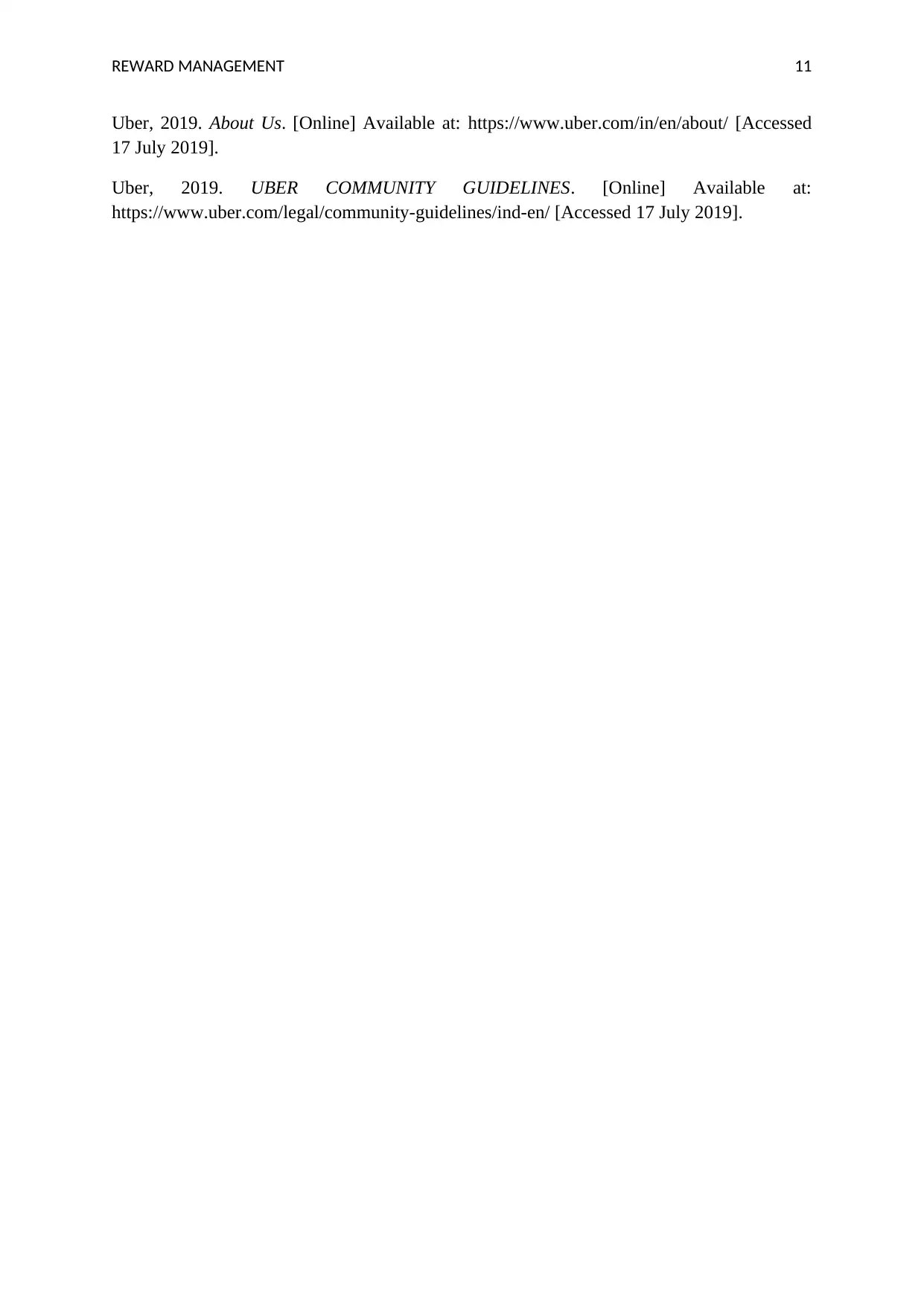
REWARD MANAGEMENT 11
Uber, 2019. About Us. [Online] Available at: https://www.uber.com/in/en/about/ [Accessed
17 July 2019].
Uber, 2019. UBER COMMUNITY GUIDELINES. [Online] Available at:
https://www.uber.com/legal/community-guidelines/ind-en/ [Accessed 17 July 2019].
Uber, 2019. About Us. [Online] Available at: https://www.uber.com/in/en/about/ [Accessed
17 July 2019].
Uber, 2019. UBER COMMUNITY GUIDELINES. [Online] Available at:
https://www.uber.com/legal/community-guidelines/ind-en/ [Accessed 17 July 2019].
⊘ This is a preview!⊘
Do you want full access?
Subscribe today to unlock all pages.

Trusted by 1+ million students worldwide
1 out of 12
Related Documents
Your All-in-One AI-Powered Toolkit for Academic Success.
+13062052269
info@desklib.com
Available 24*7 on WhatsApp / Email
![[object Object]](/_next/static/media/star-bottom.7253800d.svg)
Unlock your academic potential
Copyright © 2020–2025 A2Z Services. All Rights Reserved. Developed and managed by ZUCOL.





